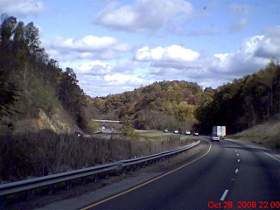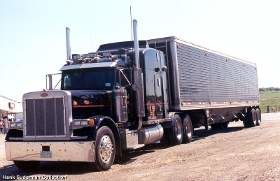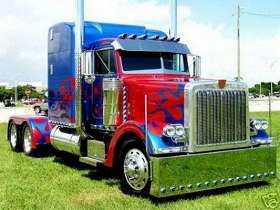Some Questions On Taking The CDL Test
Topic 3019 | Page 1

I'll try to answer as best I can.
1) During my test ( I tested in Indiana ) I did not have to stop for train tracks. The tester instead asked me if I intended to get a hazmat endorsement and if so what steps I would take at a railroad crossing. As a side note never race a train. If you can see a train coming stop and wait even if you "think" you can make it across safely.
2) Not too sure about this one. I can imagine that there is plenty of straight truck driving that requires a class B. I currently work in Chicago and see paper shredding trucks, bank/armored trucks. There's probably even more in construction you can do with a CDL B.
2.5) Double Clutching isn't that difficult so why not get all the endorsements you can get?
3) You will be able to ask questions to some extent. What will happen is the tester will explain what you need to do before you begin and then ask if you have any questions for that section. He'll do it step by step. For example, For your pre-trip inspection he'll say something like "I want you to walk around the vehicle starting on the passenger side engine and explain to me what you're looking for and why." Be confident, don't mumble and don't make it sound like you're unsure and you'll do fine.
3a) For Indiana at least. The service and Spring brake tests were the last things I tested during the In-cab pre-trip. and once that was done he said ok. now perform your 4-point air brake test. Check your CDL Handbook for your state. I know Illinois has a 7 step air brake test because they include the service and spring brake portion to that.
3b) Do it exactly as your CDL Handbook tells you to. learn it in that order and you won't miss anything.
3c) For the pre-trip you should only be inspecting what's on the vehicle. For example I tested on a vehicle that didn't have a sliding 5th wheel so I didn't have to mention what I would look for if it did. If however he asks you a specific question. Be prepared to answer him.
Pre-trip Inspection:
A pre-trip inspection is a thorough inspection of the truck completed before driving for the first time each day.
Federal and state laws require that drivers inspect their vehicles. Federal and state inspectors also may inspect your vehicles. If they judge a vehicle to be unsafe, they will put it “out of service” until it is repaired.
CDL:
Commercial Driver's License (CDL)
A CDL is required to drive any of the following vehicles:
- Any combination of vehicles with a gross combined weight rating (GCWR) of 26,001 or more pounds, providing the gross vehicle weight rating (GVWR) of the vehicle being towed is in excess of 10,000 pounds.
- Any single vehicle with a GVWR of 26,001 or more pounds, or any such vehicle towing another not in excess of 10,000 pounds.
- Any vehicle, regardless of size, designed to transport 16 or more persons, including the driver.
- Any vehicle required by federal regulations to be placarded while transporting hazardous materials.
HAZMAT:
Hazardous Materials
Explosive, flammable, poisonous or otherwise potentially dangerous cargo. Large amounts of especially hazardous cargo are required to be placarded under HAZMAT regulations
Double Clutch:
To engage and then disengage the clutch twice for every gear change.
When double clutching you will push in the clutch, take the gearshift out of gear, release the clutch, press the clutch in again, shift the gearshift into the next gear, then release the clutch.
This is done on standard transmissions which do not have synchronizers in them, like those found in almost all Class A trucks.
Double Clutching:
To engage and then disengage the clutch twice for every gear change.
When double clutching you will push in the clutch, take the gearshift out of gear, release the clutch, press the clutch in again, shift the gearshift into the next gear, then release the clutch.
This is done on standard transmissions which do not have synchronizers in them, like those found in almost all Class A trucks.

Hello, I am planning to get my cdl class b soon and I have a couple of questions that i hope you guys can answer.
1) when I do the on-road driving part of the test, when i'm preparing to drive across a railroad track and i slow down to check and there is a train coming, Do I stop and wait for the train to go by even if its completely clear that I can cross the tracks in time or should I stop and wait?(for passive tracks that don't have lights and gates)(I know this question is obvious, but Ive seached everywhere for this answer and all the rules say is slow down and check... I just want to be competely sure for the test)
2) As I said, I'm planning on getting my class B cdl. I've read that some states are now making it manditory to have manual tranny endorsements in order to drive one. Are there enough driving jobs out there that use automatic so i don't have to worry about this?
2.5) Also, I currently drive a manual station wagon, so i know how to drive one, but never driven a double clutch before (although I reseached it and know the steps). Do you think I should go ahead and attempt the manual test or play it safe and test with the automatic?
3) Will I be able to ask the instructor questions before the tests on how to do them? If not could you answer these following questions.
3a) For the pre-trip test, should i perform both brake tests or just the air brake test?
3b) About the 4 point brake check: in the back of the manual it says to do a method exactly one way, leaving out steps that was mentioned in the beginning of the manual. Steps are: Check build up rate, check governor cut in rate, and checking leak out rate before applying the brake pedal. Which way do you think I should do?
3c) How should i perform the pre-trip test, by checking the vehicle as it is, or say: "if the vehicle had this, I would do this"?
I am wanting to get my class A cdl eventually, but right now i don't have the time take the classes, and I believe that id be able to pass the class b tests without taking classes. I want to get started early on getting my experience behind the wheel for future class a positions.
Thanks for your time,
Derek
I currently have a Class B and have had for around 4-5 years. My suggestion is that you test for a manual, there are not enough trucks out there that have automatics in them that you will be assured of getting into an automatic. If you are restricted to an automatic, it will severely cut down on job possibilities. Almost not even worth doing in my opinion. Same with air brakes, you want to be sure to get that as well because most trucks have air brakes and if you don't have that, another thing in your way as far as getting a job is concerned. As far as pre-trip, you will want to test in a truck that has air brakes and depending how your CDL manual is set up, you will want to do the things such as check slack adjusters and push rods, hoses etc.... whatever your manual tells you and you will just substitute the air brake stuff in for the hydraulic brake things if that makes sense. If not, maybe someone else can think of a better way of putting it.
CDL:
Commercial Driver's License (CDL)
A CDL is required to drive any of the following vehicles:
- Any combination of vehicles with a gross combined weight rating (GCWR) of 26,001 or more pounds, providing the gross vehicle weight rating (GVWR) of the vehicle being towed is in excess of 10,000 pounds.
- Any single vehicle with a GVWR of 26,001 or more pounds, or any such vehicle towing another not in excess of 10,000 pounds.
- Any vehicle, regardless of size, designed to transport 16 or more persons, including the driver.
- Any vehicle required by federal regulations to be placarded while transporting hazardous materials.
Double Clutch:
To engage and then disengage the clutch twice for every gear change.
When double clutching you will push in the clutch, take the gearshift out of gear, release the clutch, press the clutch in again, shift the gearshift into the next gear, then release the clutch.
This is done on standard transmissions which do not have synchronizers in them, like those found in almost all Class A trucks.
HOS:
Hours Of Service
HOS refers to the logbook hours of service regulations.OWI:
Operating While Intoxicated
Hey Derek, I always recommend to people in your situation to go ahead and go for the "whole enchilada". Don't waste your time and effort on a class B when it's virtually no more trouble to get the Class A, and you open up for yourself a world of opportunities that way. Are you aware that you can get your class A with little or no out of pocket expenses by going through a Company-Sponsored Training program? Check out that link, and also do some reading in the Truck Driver's Career Guide. Trust me, you will have many more job opportunities with that class A license, and a much greater opportunity at making a decent wage. Even the folks who borrow the money for private school tuition find that they are making plenty of money to pay it back with ease once they're on the road.
I know each person's situation is unique, but I hope you'll look into this a little further and not feel so pressured to miss out on a great opportunity when it's looking you right in the face.
CDL:
Commercial Driver's License (CDL)
A CDL is required to drive any of the following vehicles:
- Any combination of vehicles with a gross combined weight rating (GCWR) of 26,001 or more pounds, providing the gross vehicle weight rating (GVWR) of the vehicle being towed is in excess of 10,000 pounds.
- Any single vehicle with a GVWR of 26,001 or more pounds, or any such vehicle towing another not in excess of 10,000 pounds.
- Any vehicle, regardless of size, designed to transport 16 or more persons, including the driver.
- Any vehicle required by federal regulations to be placarded while transporting hazardous materials.
Company-sponsored Training:
A Company-Sponsored Training Program is a school that is owned and operated by a trucking company.
The schooling often requires little or no money up front. Instead of paying up-front tuition you will sign an agreement to work for the company for a specified amount of time after graduation, usually around a year, at a slightly lower rate of pay in order to pay for the training.
If you choose to quit working for the company before your year is up, they will normally require you to pay back a prorated amount of money for the schooling. The amount you pay back will be comparable to what you would have paid if you went to an independently owned school.
Company-sponsored training can be an excellent way to get your career underway if you can't afford the tuition up front for private schooling.
I currently drive a manual station wagon
Wow! The other day someone said they had to reset the time on their VCR. And now a manual stationwagon? We're in the midst of retro week here I think!

Derek, you got great answers from everyone above. I want to say that I strongly agree with Old School about getting your class A for all the reason he mentioned. Time and time again over the years I've had people tell me, "Man, I wish I would have just gotten my Class A in the first place." Trust me, most people go back at some point and get their Class A. It's like driving all the way to Orlando just to stay at a hotel 10 miles short of Disney. Geez, another little bit would have made all the difference! Go for it!
If you can find a way to get your Class A you'll be glad you did.

Thanks everyone for your replies. You answered my questions and more..
New Reply:
New! Check out our help videos for a better understanding of our forum features

















Preview:
This topic has the following tags:
Getting Your CDL







 TT On Facebook
TT On Facebook
Hello, I am planning to get my cdl class b soon and I have a couple of questions that i hope you guys can answer.
1) when I do the on-road driving part of the test, when i'm preparing to drive across a railroad track and i slow down to check and there is a train coming, Do I stop and wait for the train to go by even if its completely clear that I can cross the tracks in time or should I stop and wait?(for passive tracks that don't have lights and gates)(I know this question is obvious, but Ive seached everywhere for this answer and all the rules say is slow down and check... I just want to be competely sure for the test)
2) As I said, I'm planning on getting my class B cdl. I've read that some states are now making it manditory to have manual tranny endorsements in order to drive one. Are there enough driving jobs out there that use automatic so i don't have to worry about this?
2.5) Also, I currently drive a manual station wagon, so i know how to drive one, but never driven a double clutch before (although I reseached it and know the steps). Do you think I should go ahead and attempt the manual test or play it safe and test with the automatic?
3) Will I be able to ask the instructor questions before the tests on how to do them? If not could you answer these following questions.
3a) For the pre-trip test, should i perform both brake tests or just the air brake test?
3b) About the 4 point brake check: in the back of the manual it says to do a method exactly one way, leaving out steps that was mentioned in the beginning of the manual. Steps are: Check build up rate, check governor cut in rate, and checking leak out rate before applying the brake pedal. Which way do you think I should do?
3c) How should i perform the pre-trip test, by checking the vehicle as it is, or say: "if the vehicle had this, I would do this"?
I am wanting to get my class A cdl eventually, but right now i don't have the time take the classes, and I believe that id be able to pass the class b tests without taking classes. I want to get started early on getting my experience behind the wheel for future class a positions.
Thanks for your time,
Derek
CDL:
Commercial Driver's License (CDL)
A CDL is required to drive any of the following vehicles:
Double Clutch:
To engage and then disengage the clutch twice for every gear change.
When double clutching you will push in the clutch, take the gearshift out of gear, release the clutch, press the clutch in again, shift the gearshift into the next gear, then release the clutch.
This is done on standard transmissions which do not have synchronizers in them, like those found in almost all Class A trucks.
OWI:
Operating While Intoxicated